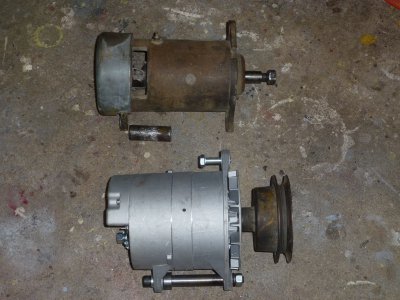- Joined
- Feb 7, 2013
- Messages
- 2,489
For what it's worth, I like to labor on Labor Day on general principles.
The generator on the D6 had failed some time ago and needed a
repair or better yet a replacement. The bearings were bad and the
key way was worn badly so opted for a new 50 amp 24 volt alternator.
The mount for the generator was a lot wider than the alternator so
had to do a bit of machining to make the alternator fit the space.
It was a struggle to remove the rod pressed into the cast iron housing
but with the use of a come along and a pipe wrench, it finally gave way.
I bored a half inch hole all the way through the rod and cut it off to
fit the alternator. I also did a skim cut on the rod so that it would be easier
to install on the CAT. Now I can run a long bolt through the rod and fasten
the alternator. The next thing will be wiring the alternator up as I don't know
if I need a regulator or if the alternator has one inside it.
The pulley was sloppy loose on the generator so I had to machine a press fit sleeve with a key way. It
seems fine now so expect it will not be problematic. Tomorrow I can install the alternator and take a look at
what will be needed to wire up the alternator.
It will be nice to use the CAT without charging the battery with a generator and battery charger every time
I want to use it.
The generator on the D6 had failed some time ago and needed a
repair or better yet a replacement. The bearings were bad and the
key way was worn badly so opted for a new 50 amp 24 volt alternator.
The mount for the generator was a lot wider than the alternator so
had to do a bit of machining to make the alternator fit the space.
It was a struggle to remove the rod pressed into the cast iron housing
but with the use of a come along and a pipe wrench, it finally gave way.
I bored a half inch hole all the way through the rod and cut it off to
fit the alternator. I also did a skim cut on the rod so that it would be easier
to install on the CAT. Now I can run a long bolt through the rod and fasten
the alternator. The next thing will be wiring the alternator up as I don't know
if I need a regulator or if the alternator has one inside it.

The pulley was sloppy loose on the generator so I had to machine a press fit sleeve with a key way. It
seems fine now so expect it will not be problematic. Tomorrow I can install the alternator and take a look at
what will be needed to wire up the alternator.
It will be nice to use the CAT without charging the battery with a generator and battery charger every time
I want to use it.

